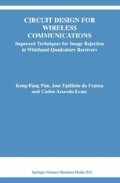Abstract
In the last two decades, we have witnessed wireless communications evolving from the first generation analog systems to the second generation digital systems (Table 1.1), with dramatic down-scaling and price decreasing of the mobile terminals as well as longer stand-by time. This evolution has been enabled by significant advances in radio and integrated circuit techniques. For example, time-division or code-devision multiple access enabled by modern digital signal processing, together with the vary large scale integrated circuit (VLSI) increased significantly radio capacity and brought the radio costs down to the consumer level [1]. Today, we are seeing the emergence of the third generation wireless communication systems capable of transmitting various services from voice to multimedia (including voice, video, data, Internet, etc) [2, 3] with ever increased bandwidth and data rates.
Access this chapter
Tax calculation will be finalised at checkout
Purchases are for personal use only
Preview
Unable to display preview. Download preview PDF.
References
C.K. Coursey, Understanding digital PCS, the TDMA Standard, Artech House, 1999.
Malcolm W. Oliphant, The mobile phone meets the internet, IEEE Communications Magazine, pp. 20 - 28, Aug. 1999.
William Sweet, Cell phones answer internets call, IEEE Spectrum, pp. 42 - 46, Aug. 2000.
P. Gray and R. Meyer, Future directions of silicon ICs for RF personal communications, in Custom Integrated Circuits Conference, 1995, pp. 83 - 90.
J.C. Rudell, J.J. Ou, et al., Recent developments in high integration multi-standard cmos transceivers for personal communication systems, Int. Sym. on Low Power Electronics, Monterey, California, 1998.
A. Abidi et al., The future of CMOS wireless transcivers, in Digest of Technical Papers, IEEE Int. Solid-State Circuit Conference, Feb. 1997, pp. 118 - 119.
V. Thomas et al., A one-chip 2 GHz single-superhet receiver for 2Mb/s FSK radio communications, in Digest of Technical Papers, IEEE Int. Solid-State Circuit Conference, San Francisco, CA, Feb. 1994, pp. 42 - 43.
T.D. Stetzler, I.G. Post, J.H. Havens, and M. Koyama, A 2.7-4.5V single chip GSM transceiver RF integrated circuit," IEEE J. Solid-State Circuits, vol. 30, no. 12, pp. 1421 - 1429, Dec 1995.
K. Irie, H. Matsui, T. Endo, et al., A 2.7V GSM RF transceiver IC, in Digest of Technical Papers, IEEE Int. Solid-State Circuit Conference, Feb. 1997, pp. 302 - 303.
P. Orsatti, F. Piazza, Q. Huang, and T. Morimoto, A 20mA-receive 55mA-transmit GSM transceiver in 0.25µm CMOS, in Digest of Technical Papers, IEEE Int. Solid-State Circuit Conference, 1999, pp. 232 - 234.
A. A. Abidi, Direct-conversion radio transceivers for digital communications, IEEE J. Solid-State Circuits, vol. 30, no. 12, pp. 1399 - 1410, Dec. 1995.
T. Tsukahara, M. Ishikawa, and M. Muraguchi, A 2V 2GHz Si-bipolar direct-conversion quadrature modulator, IEEE J. Solid-State Circuits, vol. 31, no. 2, pp. 262 - 267, Feb 1996.
J. Tang and D. Kasperkovitz, A 0.9-2.2GHz monolithic quadrature mixer oscillator for direct-conversion satellite receivers, in Digest of Technical Papers, IEEE Int. Solid-State Circuit Conference, Feb. 1997, pp. 88 - 89.
J. Crols and M. Steyaert, A 1.5GHz highly linear CMOS down conversion mixer, IEEE J. Solid-State Circuits, vol. 30, no. 7, pp. 736 - 742, July 1995.
J.C. Rudell, J.J. Ou, et al., A 1.9GHz wide-band IF double conversion CMOS receiver for cordless telephone application, IEEE J. Solid-State Circuits, vol. 32, pp. 2071 - 2088, Dec 1997.
H.J. Dressler, Interpolative bandpass A/D conversion - experimental results, IEE Electron. Letters, vol. 26, no. 20, pp. 1652 - 1653, Sept. 1990.
A.M. Thurston, T.H. Pearce, and M.J. Hawksford, Bandpass implementation of the sigma-delta A-D conversion technique, Proc. IEE Int. Conference on A/D and D/A Conversion, Swansea, U.K., pp. 81 - 86, Sept. 1991.
S.A. Jantzi, W.M. Snelgrove, and P.F. Ferguson Jr., A fourth-order bandpass sigma-delta modulator, IEEE J. Solid-State Circuits, vol. 28, no. 3, pp. 282 - 291, March 1993.
S. Jantzi, R. Schreier, and M. Snelgrove, The design of bandpass DE ADCs, in Delta-Sigma Data Converters, Theory, Design and Simulation, S. Norsworthy, R. Schreier, and G.C. Ternes, Eds., pp. 282-308. IEEE Press, 1997.
D.K. Weaver, A third method of generation and detection of singlesideband signals, Proc. IRE, vol. 44, pp. 1703 - 1705, Dec 1956.
Behazad Razavi, Design consideration for direct-conversion receivers, IEEE Trans. on Circuits and Systems - II: Analog and Digital Signal Processing, vol. 44, no. 6, pp. 428 - 435, June 1997.
F.E. Churchill, G.W. Ogar, and B.J. Thompson, The correction of I and Q errors in a coherent processor, IEEE Transactions on Aerospace and Electronic Systems, vol. AES-17, no. 1, pp. 131 - 137, Jan 1981.
Li Yu and W. M. Snelgrove, A novel adaptive mismatch cancellation system for quadrature IF radio receivers, IEEE Transactions on Circuits and Systems: - II: Analog and digital signal processing, vol. 46, no. 6, pp. 789 - 801, June 1999.
J. Crois and M. Steyaert, An analog integrated polyphase filter for a high performance low-if receivers, in Proc. VLSI Circuits Symposium, Kyoto, June 1995, pp. 87 - 88.
T. Okanobu, H. Tomiyama, and H. Arimoto, Advanced low voltage single chip radio IC, IEEE Trans. Consumer Electronics, vol. 38, no. 3, pp. 465475, August 1992.
E. van der Zwan, K. Philips, and C. Bastiaansen, A 10.7MHz IF-tobasebad DE A/D conversion system for AM/FM radio receivers, in Digest of Technical Papers, IEEE Int. Solid-State Circuit Conference, Feb. 2000, pp. 340 - 341.
Author information
Authors and Affiliations
Rights and permissions
Copyright information
© 2003 Springer Science+Business Media Dordrecht
About this chapter
Cite this chapter
Pun, KP., da Franca, J.E., Azeredo-Leme, C. (2003). Introduction. In: Circuit Design for Wireless Communications. The Springer International Series in Engineering and Computer Science, vol 728. Springer, Boston, MA. https://doi.org/10.1007/978-1-4757-3737-0_1
Download citation
DOI: https://doi.org/10.1007/978-1-4757-3737-0_1
Publisher Name: Springer, Boston, MA
Print ISBN: 978-1-4419-5349-0
Online ISBN: 978-1-4757-3737-0
eBook Packages: Springer Book Archive

